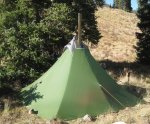Nice to not the edge in your face that's usable space to me
Sent from my XT1585 using Tapatalk
Sent from my XT1585 using Tapatalk
Follow along with the video below to see how to install our site as a web app on your home screen.
Note: This feature may not be available in some browsers.
I still maintain it is largely a psychological difference and not a practical one.
Tipis of equal height and equal roof angle will have the same usable space and weigh the same regardless if one has a small vertical wall and one doesn't.
The only difference is that you can SEE the unused space without the wall, and you need a ton more guylines with the sidewall.


I toyed with this idea as well but a little differently. Basically I was going to sew a zipper or verlcro around the bottom edge of my SL5. I could then add in as necessary a bug net or solid skirt or leave it with nothing at all.
But, that was modifying an existing shelter, not building a new one from scratch.
Hate to make a wall of quotes but on topic with wall tie outs...Well it seems we agree to disagree. Of course its akin to Monday Morning QB'ing here...just sharing my take.
Raising these tipis up- made all the difference to me in usable space when it comes to real world experience with these tipis; sitting up, having your sleeping bag close to the wall with condensation, etc. Then there is the advantage of the venting and convection currents the short wall gives you.
Heres a diagram though it doesn't truly illustrate the issues I've had with this perimeter space. This is the same dimensions of my old SL-5. I always found myself and my bag into that triangle. In reality, that perimeter had much less space than the 1 foot from the perimeter as shown here as 9 1/4"....more like 6".... I think due to stretch and pitch.
View attachment 59122
My MM QB take; The tipi with the catenary cut SL-5's, Tigoat [concave walls] does a better job of tightening the tipi by design....no doubt their reasoning. ....but then it leaves you with less space on the perimeter. Beentheredonethat. Sure you can try to utilize that space but you can't argue the fact stuff in that space will get soaked due to condensation rolling down.
Heres an actual of my old SL5 in Co unit 76 at 10,700'. That high mtn cold air at night made it a condensation nightmare.
View attachment 59128
Interesting to note that tying off the straight wall tipis and the catenary designs is different and the straight wall tipis benefit from a straight pull follwing the line of the seam to the ground while the Cat cut tipis you can pull them outward.
Good idea Brad and I think it would really help make that SL5 a better structure. I was going to go with velcro on mine...then changed it mid stream. I think my next will be sewn mosquito netting around the entire perimeter with some velcro in sections at the top edge of the netting so I can add some solid wall panels - appx 50/50. I will be using the light version [next design] in early season so I want just about the entire thing vented.


Extra stakes, extra guy outs (mostly on tipi as the don't need it), extra seams depending on size and a few other factor, more fabric again depending on how it's done. It all adds up.Why would it weigh more? I haven't done exact calculations but it should be less material needed for the vertical walls then for extending the walls at an angle. Granted, you then have another seam to sew probably so that can add weight. Just curious.
Why would it weigh more? I haven't done exact calculations but it should be less material needed for the vertical walls then for extending the walls at an angle. Granted, you then have another seam to sew probably so that can add weight. Just curious.
No skin off my back. I sold the SL5 for the Cimarron a while ago. Mostly I was just talking about ways to "improve" existing tents versus creating and sewing your own. To me, with an existing shelter, just sewing on a skirt of solid or net is a simple solution that allows you to increase space in the tent and increase ventilation. Without a lot of mods, you wouldn't be able to move the stake points on an existing shelter so by just sewing on a skirt, you can just run extensions on the stake points and achieve the goal.
Now, when designing a shelter from scratch, I can't disagree with the idea that the vertical walls probably cause more problems then they solve.
One other thing to remember, when you do have condensation, it usually runs down the side to the bottom of the wall. With a vertical wall, this condensation will hit that wall and then drop or run down it. If you are right next to the wall, you might get a bit wet.
Depends on the applicationI'm like a kid in a candy store here as a newby ripstop DIY'er. You all publishing your ideas, trial and errors has me spinning in a whirlpool of information. Just need to buckle down and go with one of these awesome designs for my own experience. One question, does the parallel double stitch work better than a zig-zag?
That actually works pretty well but it makes your seems off center which on a tipi or mid doesn't matter but on some other types of shelter builds it will need to be accounted forI just fold both layers of fabric twice at 5/8”. Probably blasphemy in pro sewing circles but its easy...no inside out, cutting different lengths, matching different patterns or lengths.
I cut all pieces the same (from a paper pattern of the piece) adding 1 1/4” seam bias per side, iron pieces together with heat seal hem tape, then fold and sew
That actually works pretty well but it makes your seems off center which on a tipi or mid doesn't matter but on some other types of shelter builds it will need to be accounted for


